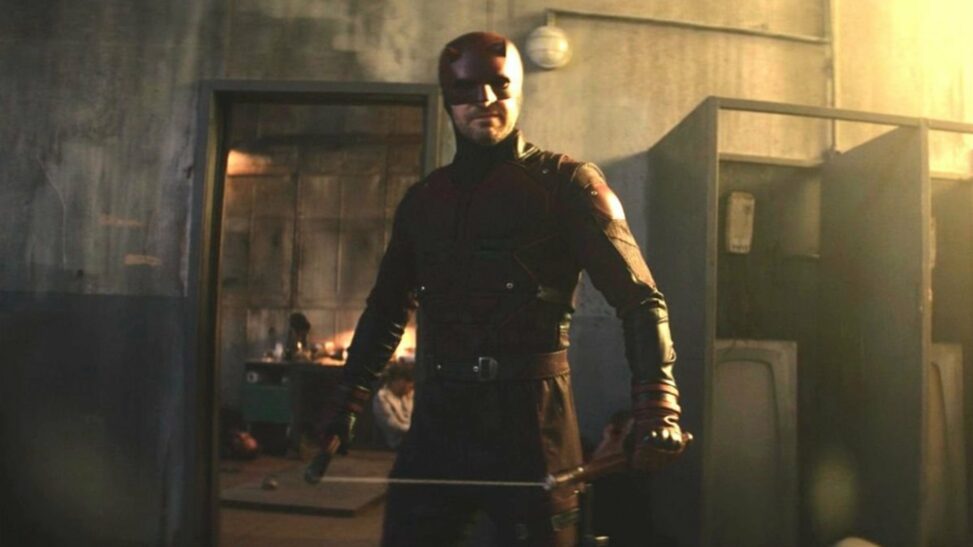In the first episode of Marvel’s Daredevil: Born Again, one of the most gripping moments is the action sequence at Josie’s Bar. This scene doesn’t just deliver excitement — it helps set the gritty tone of the entire series. It reintroduces Matt Murdock (Daredevil) in a way that emphasizes both his vulnerability and his strength, making for a great opportunity to analyze how the show handles action, violence, and representation.
The scene takes place in a dimly lit, smoke-filled bar. This setting contributes to a dark, almost claustrophobic atmosphere, which adds tension but also makes some of the action hard to follow. According to Pete Volk, the visuals are “undersaturated” and at times obstructive, which makes the choreography difficult to clearly see (Volk 2025). The show aims for a gritty, grounded aesthetic, and the lighting choices reflect that — even if it comes at the cost of visual clarity.
The scene is filmed using a long, continuous take, which helps immerse viewers in the moment. The directors, Justin Benson and Aaron Moorhead, described the camera’s movement as being like “train tracks of fate,” suggesting that it’s following the characters through events that feel destined to happen (Benson and Moorhead 2025). This approach, while stylish, also reminds us that everything is carefully choreographed.
The fight between Daredevil and Bullseye is brutal and exhausting. The punches are heavy, and the characters visibly wear down as the scene goes on. It’s clear this isn’t just flashy fighting — it’s meant to feel real. This fits with how the series portrays vigilante violence as messy and painful.
When it comes to representation, the focus in this fight is mostly on male characters, which is pretty typical for the action genre. However, Daredevil being a blind superhero adds another dimension. His disability isn’t shown as a limitation but as something he’s adapted to in ways that give him an edge in combat. According to Kim Norton and Tracy Karner, media often shows disabled characters as either tragic or superhuman — Daredevil walks that line, leaning toward the heroic extreme (Norton and Karner 2003). He’s still vulnerable, though, which makes him feel more human and relatable.
Because of the long take, there aren’t obvious cuts to count during the one-minute sequence. This choice is supposed to make the fight feel seamless, like we’re watching it in real-time. Still, there are moments where the camera’s path — weaving through doors and hallways — draws attention to itself. Benson and Moorhead admitted this was intentional, saying the camera is designed to give a sense that “it already knows how this goes” (Benson and Moorhead 2025). So, while the editing feels smooth, we’re still aware that we’re watching something carefully staged.
In the book Spectacular Bodies, Yvonne Tasker argues that action films often focus on “muscularity” and toughness, especially in male leads (Tasker 1993). Daredevil fits this mold in some ways — he’s incredibly resilient, always fighting through pain. But the show also highlights his internal struggle, setting him apart from more traditional “invincible” action heroes.
Carol Clover’s work on gender in horror and action genres also applies here. She talks about how men are often placed in roles of dominance and physical control, while women and others are sidelined or victimized (Clover 1992). In this scene, there are no women present, and the story centers on a personal conflict between two men. That’s a common setup in action media, and it reinforces some long-standing gender tropes.
Since Daredevil: Born Again is on Disney+, it doesn’t have traditional box office numbers. However, it was one of the most streamed series during its debut week in March 2025, according to data from Box Office Mojo. This shows that despite some critiques, audiences were clearly eager to see Daredevil back in action.
There’s a lot of discussion around how violent media affects people. Some scholars argue that repeated exposure can desensitize viewers or even increase aggression, especially when violence is shown without real consequences. But the research is mixed. Tasker points out that context matters — audiences bring their own understanding to what they watch, and not everyone reacts the same way (Tasker 1993). In Daredevil: Born Again, violence is shown as exhausting and painful, which may help prevent viewers from glorifying it.


Shanny Ndirangu
The analysis of Daredevil: Born Again’s opening action sequence is thorough and compelling, especially in how it connects the scene’s aesthetics to larger thematic goals. I generally agree with the assessment: the gritty tone, long take, and use of lighting all work to immerse the viewer in Daredevil’s world. The critique of visual clarity is valid while the dim lighting serves mood, it occasionally obscures the choreography, a tension Pete Volk rightly highlights.
The piece effectively incorporates scholarly research, especially through Yvonne Tasker’s and Carol Clover’s frameworks, to examine masculinity and gender representation. The writer uses these theories to critique the scene’s gender dynamics and reinforce how Daredevil aligns with and deviates from genre norms. The use of Norton and Karner’s work on disability in media further deepens the analysis, making the representation discussion feel informed and multidimensional.
However, while the scholarly references are well-integrated, there could be more engagement with how these frameworks critique or challenge the genre conventions being employed. For instance, Clover’s ideas on male dominance could have been tied more directly to character development across the series. The described image of a dim, smoky bar matches the gritty aesthetic discussed, reinforcing the thematic tone.